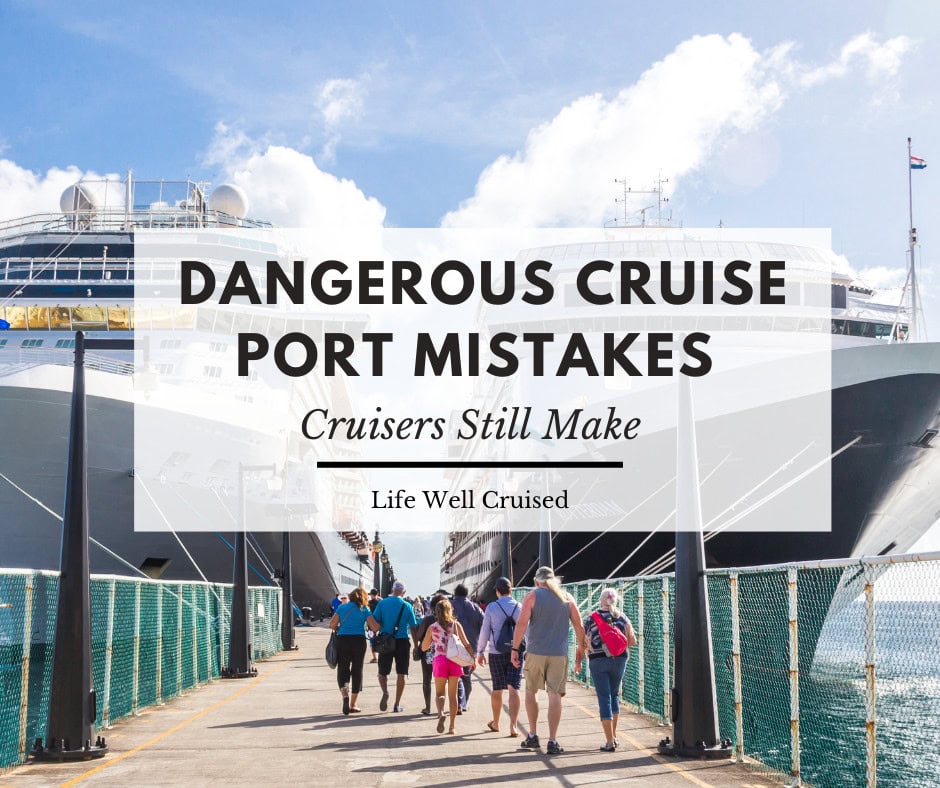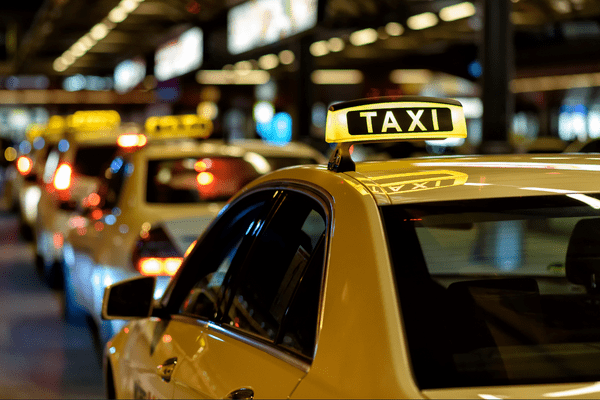
- Ethan Schattauer
- May 31, 2025
15 Dangerous Cruise Port Mistakes Cruisers Still Make in 2025
Cruise ports can be the most exciting part of your trip, but they are also where many travelers make costly mistakes. From scams and safety concerns to planning slip-ups and tourist traps, even a simple misstep can ruin your day ashore.
Whether you are sailing with Royal Caribbean, Carnival, Norwegian, MSC, or another cruise line, knowing what to watch for can make all the difference. These tips will help you avoid common cruise port mistakes, stay safe, and enjoy your port days with confidence.
Here are 15 cruise port mistakes to avoid on your next sailing
Dangerous Cruise Port Mistakes Cruisers Have to Avoid
1. Not Knowing Where Your Ship Is Docked

Some cruise ports have multiple terminals located miles apart. If you’re unaware of which terminal your ship is docked at, you could end up in the wrong place after a day out and possibly miss the ship.
For example, in St. Thomas, ships may dock at either Havensight or Crown Bay, which are about 45 minutes apart. In Ketchikan, most ships dock downtown, but Norwegian Cruise Line docks at Ward Cove, about 20 minutes away.
Always confirm your ship’s dock location before disembarking, and make sure your taxi driver knows exactly where to go.
2. Falling for “Helpful” Strangers
Be cautious of strangers pointing out that your bag is dirty or that you’ve dropped something. These distractions are often a tactic used by pickpockets working in pairs.
One person distracts you while the other attempts to steal from your bag or pockets!
Other scams may be more subtle but still target tourists. A taxi driver might suggest a better beach but is actually bringing you to a spot where they earn a commission.
It’s common for restaurants to offer “tourist menus” with inflated prices. Furthermore, locals offering to help you spot wildlife in some destinations may demand a tip afterward.
3. Currency Conversion Tricks
When shopping or withdrawing money in a foreign country, you might be offered the option to pay in your home currency instead of the local one. It may seem convenient, but this is often a trap that comes with a significantly worse exchange rate.
Vendors, ATMs, and even credit card machines sometimes apply a hidden markup when converting the total to your home currency. To avoid this unnecessary expense, always choose to be charged in the local currency and let your bank or credit card provider handle the conversion.
You will usually get a much better exchange rate and save money without even realizing it.
4. Forgetting Port Day Essentials

Even if you are only planning to walk around the port for a short time, it is important to be prepared. Cruise ports can be hot, crowded, and unpredictable, so having the right items with you can make a big difference.
Essentials like sunscreen, a reusable water bottle, some cash, and a credit card can help you stay comfortable and avoid unnecessary stress. Most importantly, never leave the ship without your phone, as it can be vital in an emergency or if you need directions or help.
Furthermore, a small crossbody bag or daypack is perfect for keeping everything secure and easily accessible.
Related: 75 Must-have Cruise Essentials from Amazon
5. Using Free Public Charging Stations
While it might be tempting to charge your phone at a free USB station in a port terminal or café, these can pose serious security risks. Some public charging stations are set up with malicious software that can access your personal data through a process known as USB skimming.
This can leave your phone vulnerable to tracking, data theft, or even malware. To protect your information, it is best to carry your own portable charger or power bank when you head ashore. It is a simple precaution that helps keep your device charged and your data secure.
6. Relying on Public Wi-Fi

Free Wi-Fi at coffee shops, restaurants, or port terminals might seem like a convenient way to check emails or post updates, but it comes with risks. Public networks are often unsecured, which means hackers can intercept the information you send and receive.
This can include login details, credit card numbers, and other sensitive data. If you do need to connect, avoid logging into personal accounts or making any financial transactions.
For a safer alternative, consider using a personal hotspot or travel eSIM that offers secure, private internet access while you explore.
7. Booking With Unverified Tour Providers
It can be tempting to book a shore excursion with a third-party provider, especially when the price is lower than what the cruise line offers. However, not all tour operators are legitimate, and some travelers have fallen victim to fake websites or providers that take payment but never deliver the service.
These scams can result in lost money and wasted port days, or even worse, missing your ship if the tour runs late. Before booking, always check for verified reviews, a clear refund policy, and proper contact information.
When in doubt, stick with excursions offered through the cruise line or a well-known, trusted provider.
8. Overexerting Yourself on Excursions
It is easy to get caught up in the excitement of exploring a new destination and sign up for an adventurous excursion, but not every activity is suitable for every traveler. Some shore excursions, while popular, can be physically demanding.
If you have mobility issues, joint pain, or simply prefer a slower pace avoid excursions like climbing waterfalls, hiking rugged trails, or navigating uneven terrain as these activities may put you at risk of injury.
Always read the excursion descriptions carefully and pay attention to words like “strenuous” or “high activity.” Choosing an experience that matches your comfort and fitness level ensures you enjoy your time ashore and return to the ship safely.
9. Visiting Unsafe Areas
Most cruise ports are generally safe in well-traveled areas, but just like any city, there are neighborhoods that are best avoided. Venturing too far off the beaten path without doing research can put you at risk, especially in destinations with higher crime rates
Areas near some ports, such as Nassau, San Juan, Belize, or Roatán, may have parts that are not recommended for tourists. Before heading out on your own, take time to read travel advisories or ask cruise staff for guidance.
When in doubt, consider booking a guided tour or staying within well-known tourist zones to explore comfortably and safely.
10. Oversharing Travel Plans Online
Posting cruise details on social media might seem harmless, but it can open the door to scams and privacy breaches. In recent months, cruise lines have warned guests about fake emails and messages claiming to be from the cruise company, often tricking people into paying bogus port fees or sharing booking information.
In some cases, scammers have even used this information to cancel or alter passenger reservations. Avoid posting photos of boarding passes, cabin numbers, or cruise itineraries online, especially before or during your trip.
Keeping your travel plans private helps protect you from digital fraud and keeps your vacation stress-free.
11. Taking Unlicensed Taxis

Not all taxis waiting outside cruise ports are legitimate, and getting into the wrong one can lead to inflated fares, unsafe conditions, or worse. Unlicensed drivers often approach tourists with offers that seem cheaper than official rates, but once the ride begins, the price may suddenly increase or unexpected fees might be added.
These drivers usually operate without oversight and may demand cash-only payment, leaving you with little recourse if something goes wrong. To stay safe, use clearly marked, licensed taxis or arrange transportation in advance through the cruise line or a reputable service.
Taking a few extra minutes to verify your ride can save you time, money, and unnecessary stress.
Related: New Tourist Scams that Are Targeting Cruise Travelers (Right Now)
12. Buying Counterfeit or Unsafe Products
It is easy to get lured in by street vendors offering designer bags, watches, perfumes, or even local goods like vanilla extract at prices that seem too good to pass up. However, many of these items are counterfeit and may not meet safety or quality standards.
In some cases, products can even be harmful, especially if they are consumables or skincare items with unknown ingredients. Buying from unofficial vendors also means there is no way to return the item or hold the seller accountable.
To avoid disappointment or health risks, shop only from reputable stores and look for quality certifications when purchasing local products.
13. Forgetting Your All Aboard Time
Missing your ship is one of the most avoidable cruise mistakes, and it usually comes down to not knowing or misjudging the all aboard time. Cruise ships run on ship time, which may be different from the local port time, and that confusion has caused many travelers to return too late.
A helpful habit is to take a photo of the all aboard sign as you exit the ship so you have a clear reminder later in the day. Make sure your phone or watch is set to ship time, especially if your device updates automatically based on your location. Being even a few minutes late can result is missing your cruise ship.
14. Leaving Valuables Unattended at the Beach

A relaxing beach day can quickly go wrong if your belongings are stolen while you are in the water. Even at beaches popular with cruise passengers, unattended bags can be easy targets for opportunistic thieves.
It is never a good idea to leave valuables like credit cards, identification, cash, or your phone in a beach bag on the sand.
Instead, use a waterproof lanyard or waist pouch that you can wear into the water to keep your essentials secure. This simple precaution lets you enjoy your beach day without constantly worrying about what is happening to your belongings on shore.
15. Ignoring Digital Privacy Risks
While many travelers focus on avoiding in-person scams, digital threats are just as common and often harder to detect. When you book cruises, flights, or even browse travel deals online, your personal information can be collected and sold by data brokers without your knowledge.
This data such as your name, email, phone number, and travel habits can then be used by scammers to target you with fake deals or phishing attempts. Protecting your digital footprint is essential, especially before and during travel.
Using services that help remove your data from broker sites and being mindful of what you share online can go a long way in safeguarding your personal information.
Related & Popular Posts:
Happy Cruising!
Ethan
Ethan Schattauer, a seasoned cruiser since the age of four, has gone on over 40 cruises with his family. Drawing from his extensive travel experiences, Ethan offers a fresh and youthful perspective on the world of cruising. He also writes about cruise cuisine, onboard experiences, and practical tips, providing valuable insights for cruise travelers worldwide.
